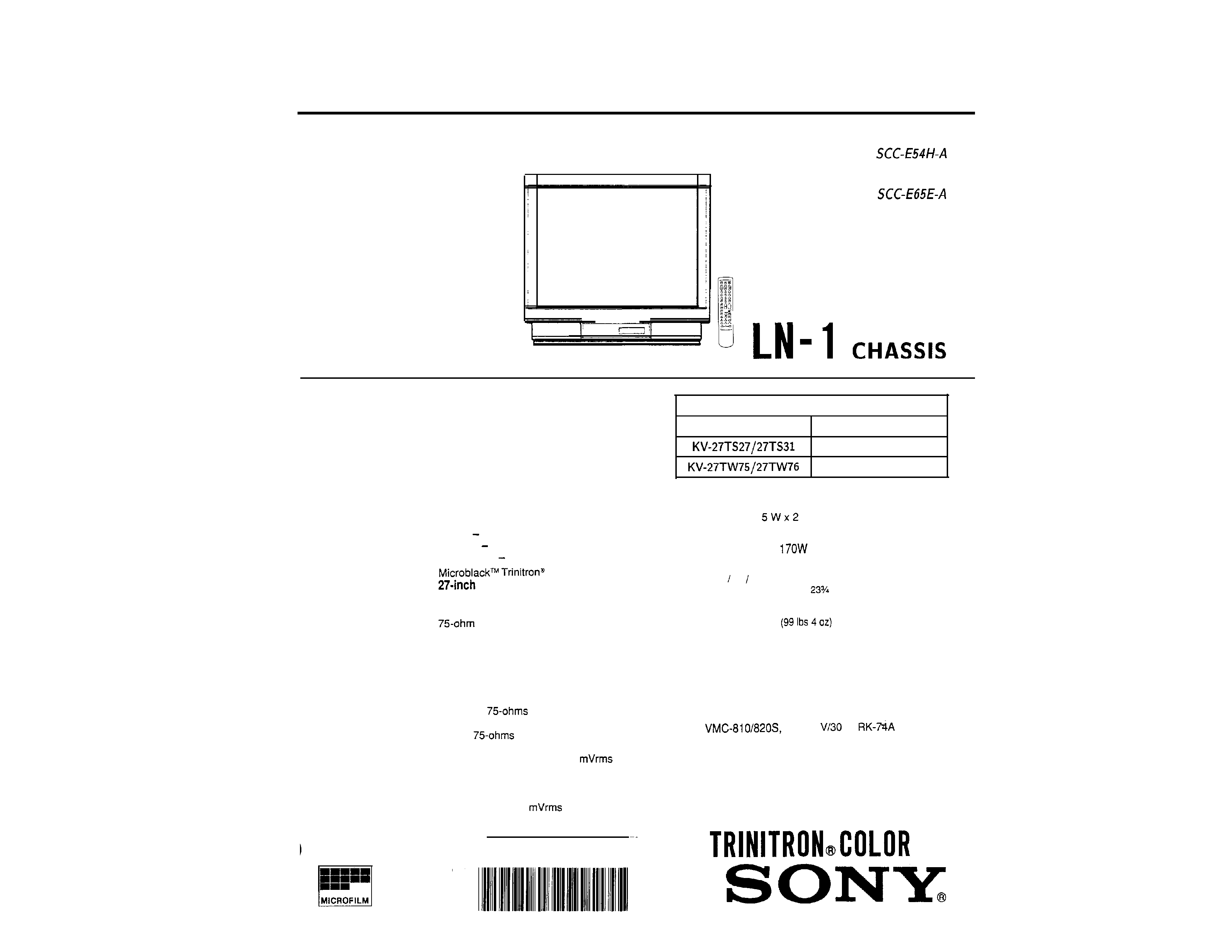
KV-32TS35
SERVICEMANUAL
RM-Y102
US Model
Chassis No.
Canadian Model
Chassis No.
MODELS OF THE SAME SERIES
KV-27TS35
SPECIFICATIONS
Television system American TV standards
Channel coverage VHF: 2
13
UHF: 14
69
Picture
tube
Antenna
Input
Cable TV: 1
125
tube
picture measured diagonally
28-inch picture tube measured
diagonally
external
antenna
terminal
for
VHF/UHF
VIDEO and S VIDEO
S VIDEO IN (S terminal)
Y: 1 Vp-p, 75-ohms
unbalanced,
sync
negative
C: 0.286 Vp-p (Burst signal),
Video (phono jacks): 1 Vp-p,
unbalanced,
sync
negative
output
Audio (phono jacks): 500
(100% modulation)
Impedance: 47 kilohms
AUDIO
OUT
(VARIABLE)
(phono
jacks)
More than 408
at the
maximum
volume
setting
(variable)
Impedance: 5 kilohms
Speaker output
Power
requirements
120 V AC, 60 Hz
Power consumption
5W Standby mode
Dimensions (w
h
d)
660.5x602.5 x468 mm
(26% x
x 18% in.)
Weight
46 kg
Supplied accessories
Remote commander RM-Y 102 (1) with 2 size AA
(R6) EVEREADY batteries
Recommended
accessories
U/V mixer EAC-66
Connecting cable
YC-15
V,
Design
and
specifications
are
subject
to
change
without
notice.
TV
996479501
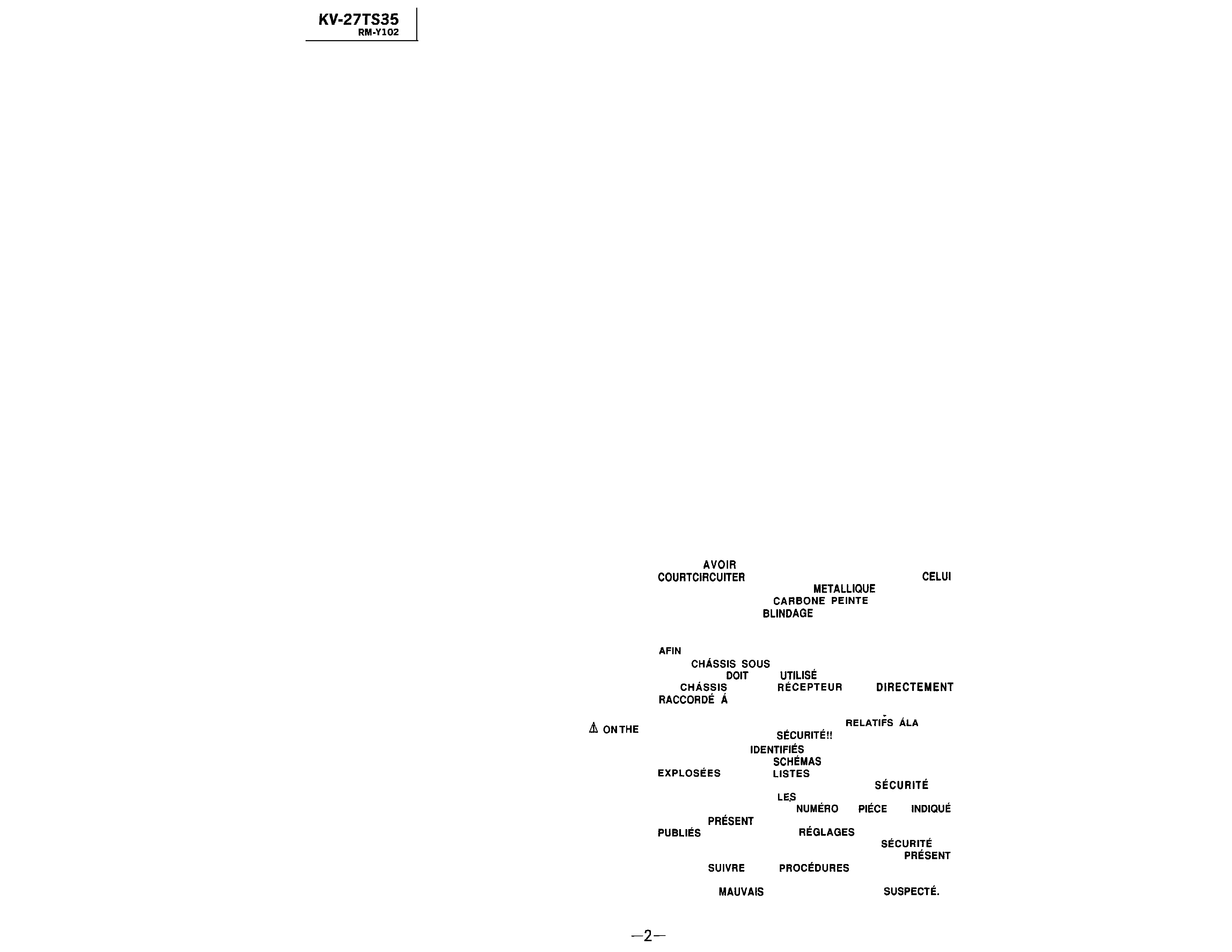
(CAUTION)
SHORT CIRCUIT THE ANODE OF THE PICTURE TUBE AND THE
ANODE CAPTOTHE METAL CHASSIS, CRTSHIELD, OR CARBON
PAINTED ON THE CRT, AFTER REMOVING THE ANODE.
WARNING!!
AN
ISOLATION
TRANSFORMER
SHOULD
BE
USED
DURING
ANY SERVICE TO AVOID POSSIBLE SHOCK HAZARD, BECAUSE
OF LIVE CHASSIS.
THE CHASSIS OF THIS RECEIVER IS DIRECTLY CONNECTED
TO THE AC POWER LINE.
SAFETY-RELATED
COMPONENT
WARNING
!!
COMPONENTS IDENTIFIED BY SHADING AND MARK
SCHEMATIC DIAGRAMS, EXPLODED VIEWS AND IN THE PARTS
LIST ARE CRITICAL TO SAFE OPERATION. REPLACE THESE
COMPONENTS WITH SONY PARTS WHOSE PART NUMBERS
APPEAR AS SHOWN IN THIS MANUAL OR IN SUPPLEMENTS
PUBLISHED
BY
SONY.
CIRCUIT
ADJUSTMENTS
THAT
ARE
CRITICAL
TO
SAFE
OPERATION
ARE
IDENTIFIED
IN
THIS
MANUAL.
FOLLOW
THESE
PROCEDURES
WHENEVER
CRITI-
CAL COMPONENTS ARE REPLACED OR IMPROPER OPERA-
TION IS SUSPECTED.
(ATTENTION)
APRES
DECONNECTE
LE
CAP
DE
L'ANODE,
L'ANODE DU TUBE CATHODIQUE ET
DE L'ANODE DU CAPAU CHASSIS
DE L'APPAREIL,
OU AU COUCHE DE
SUR LE TUBE
CATHODIQUE OU AU
DU TUBE CATHODIQUE.
ATTENTION!!
D'EVITER TOUT RISQUE D'ELECTROCUTION PROVENANT
D'UN
TENSION, UN TRANSFORMATEUR
D'ISOLEMENT
ETRE
LORS DETOUT DEPANNAGE.
LE
DE CE
EST
L'ALIMENTATION SECTEUR.
ATTENTION AUX COMPOSANTS
LES COMPOSANTS
PAR UNE TRAME ET PAR UNE
MAPQUE
A SUR LES
DE PRINCIPE, LES VUES
ET LES
DE PIECES CONT D'UNE
IMPORTANCE
CRITIQUE
POUR
LA
DU
FONCTIONNEMENT.
NE
REMPLACER
QUE
PAR
DES
COMPOSANTS SONY DONTLE
DE
EST
DANS LE
MANUEL OU DANS DES SUPPLEMENTS
PAR
SONY.
LES
DE CIRCUIT DONT
L'IMPORTANCE EST CRITIQUE POUR LA
DU
FONCTIONNEMENT
SONT
IDENTIFIES
DANS
LE
MANUEL.
CES
LORS
DE
CHAQUE
REMPLACEMENT
DE
COMPOSANTS
CRITIQUES,
OU
LORSQU'UN
FONCTIONNEMENT EST
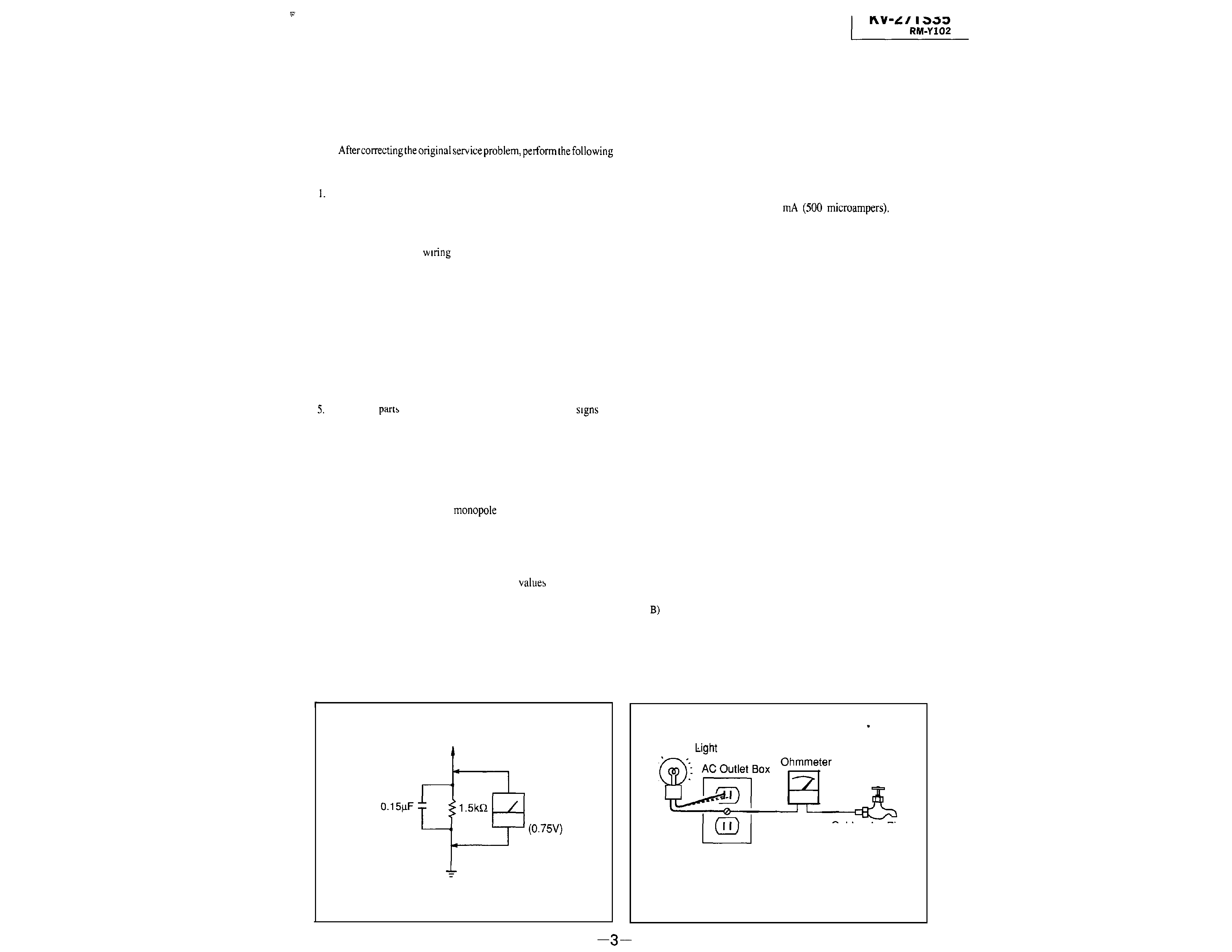
SAFETY CHECK-OUT
(US
Model
only)
safety checks before releasing the set to the customer
Check the area of your repair for unsoldered or poorly-soldered
connections. Check the entire board surface for solder splashes
and
bridges.
2.
Check the interboard
to ensure that no wires are "pinched"
or
contact
high-wattage
resistors.
3
Check that all control knobs, shields, covers, ground straps, and
mounting hardware have been replaced. Be absolutely certain that
you have replaced all the insulators
4
Look
for
unauthorized
replacement
parts,
particularly
transistors,
that were installed during a previous repair Point them out to the
customer and recommend their replacement.
Look for
which, though functioning, show obvious
of
deterioration. Point them out to the customer and recommend
their
replacement.
6.
Check the line cord for cracks and abrasion Recommend the
replacement of any such line cord to the customer
7.
Check the condition of the
antenna (if any).
Make sure the end is not broken off, and has the plastic cap on it.
Point out the danger of impalement on a broken antenna to the
customer, and recommend the antenna's replacement.
8.
Check the B+ and HV to see they are at the
specified. Make
sure your instruments are accurate; be suspicious of your HV
meter if sets always have low HV.
9.
Check the antenna terminals, metal trim, "metallized" knobs,
screws, and all other exposed metal parts for AC leakage Check
leakage as described below
To Exposed Metal
Parts on Set
AC
voltmeter
Earth Ground
Fig A. Using an AC voltmeter to check AC leakage
Fig. B. Checking for earth ground.
LEAKAGE
The AC leakage from any exposed metal part to earth ground and
from all exposed metal parts to any exposed metal part having a return
to chassis, must not exceed 0.5
Leakage
current can be measured by any one of three methods.
1.
A commercial leakage tester, such as the Simpson 229 or RCA
WT-540A. Follow the manufacturers' instructions to use these
instruments.
2.
A battery-operated AC milliammeter. The Data Precision 245
digital multimeter is suitable for this job.
3.
Measuring the voltage drop across a resistor by means of a VOM
or battery-operated AC voltmeter The "limit" indication is 0.75
V, so analog meters must have an accurate low-voltage scale The
Simpson 250 and Sanwa SH-63Trd are examples of a passive
VOM that is suitable. Nearly all battery operated digital multimeters
that have a 2V AC range are suitable. (See Fig. A)
HOW TO FIND A GOOD EARTH GROUND
A cold-water pipe is guaranteed earth ground; the cover-plate
retaining screw on most AC outlet boxes is also at earth ground. If the
retaining screw is to be used as your earth-ground, verify that it is at
ground by measuring the resistance between it and a coldwater pipe
with an ohmmeter. The reading should be zero ohms. If a cold-water
pipe is not accessible, connect a 60-100 watts trouble light (not a neon
lamp) between the hot side of the receptacle and the retaining screw.
Try both slots, if necessary, to locate the hot side of the line, the lamp
should light at normal brilliance if the screw is at ground potential. (See
Fig.
Trouble
Cold-water Pipe
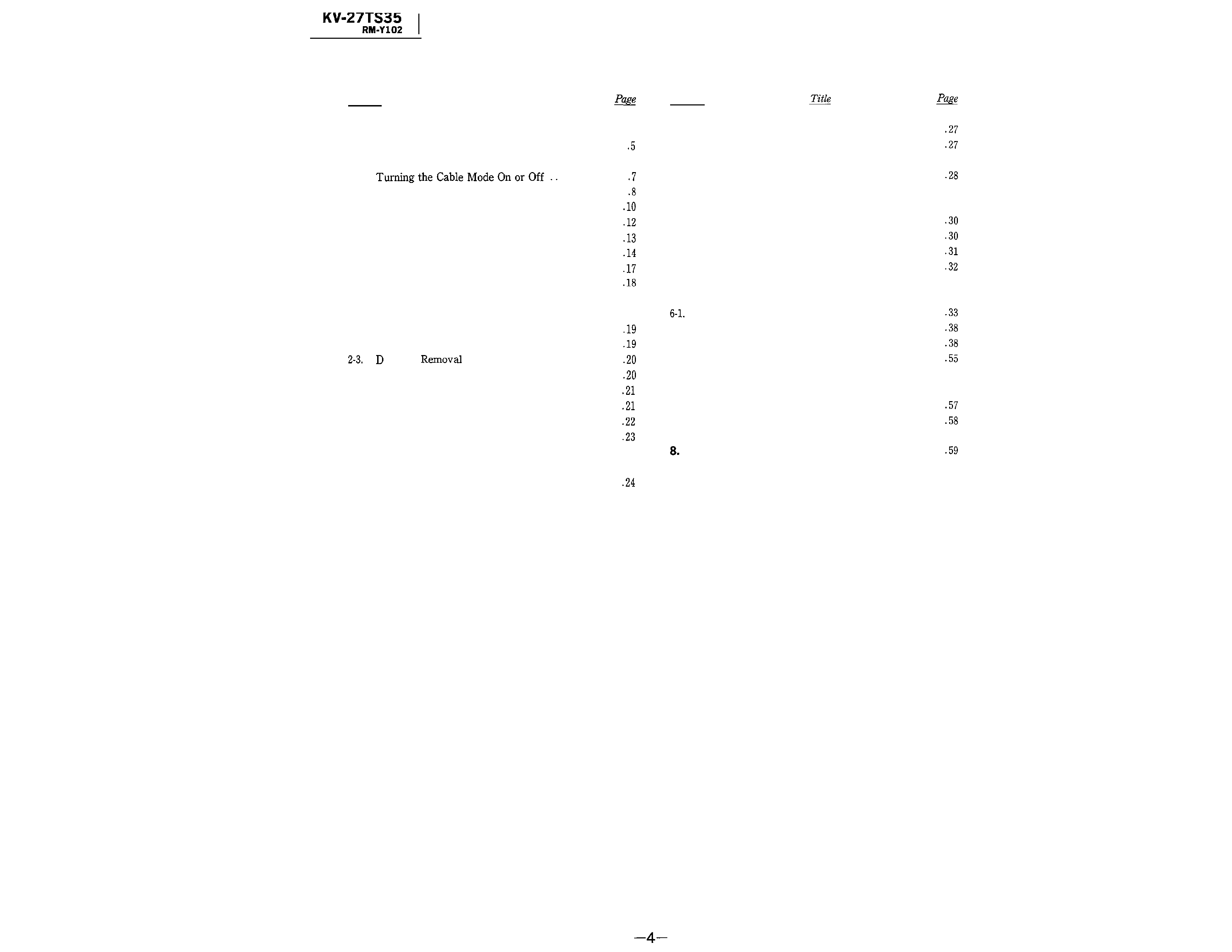
TABLE OF CONTENTS
Section
Title
1. GENERAL
l-l.
Locating the Controls
...........................
1-2.
Connecting TV Antenna/Cable ................
7
1-3.
.............
l-4.
Presetting TV Channels ........................
l-5.
Using
Picture-in-Picture .......................
1-6.
Using the Pre-Programmed Remote Commander .
1-7.
Setting the CURRENT TIME ...................
1-8. Using the Timer-activated Functions-GUIDE ...
1-9.
Using CHANNEL CAPTION ...................
l-10. Enjoying Other Useful Features .................
2.
DISASSEMBLY
2-1.
Rear Cover Removal
.......................
2-2.
Service Position
...............................
Board
...............................
2-4.
Antenna Terminal Board Removal ...............
2-5.
B, A and E Boards Removal.. .................
2-6.
How to Improve Interlace .......................
2-7.
B, A and E Boards Service Position .............
2-8.
Picture Tube Removal .....................
3. SET-UP ADJUSTMENTS
3-1.
Beam Landing ..............................
3-2.
Convergence
.............................
..2 5
Section
3-3.
Focus Adjustment .....................
3-4.
White Balance ..............................
4.
SAFETY RELATED ADJUSTMENTS ..........
5. CIRCUIT ADJUSTMENTS
5-1.
A Board Adjustments
......................
5-2.
B Board Adjustments ...................
5-3.
D Board Adjustments ......................
5-4.
E Board Adjustments .....................
6. DIAGRAMS
Block Diagram .............................
6-2.
Circuit Boards Location ...................
6-3.
Printed Wiring Boards and Schematic Diagrams .
6-4.
Semiconductors
..........................
7. EXPLODED VIEWS
7-l.
Chassis. ..................................
7-2.
Picture Tube .............................
ELECTRICAL PARTS LIST ............
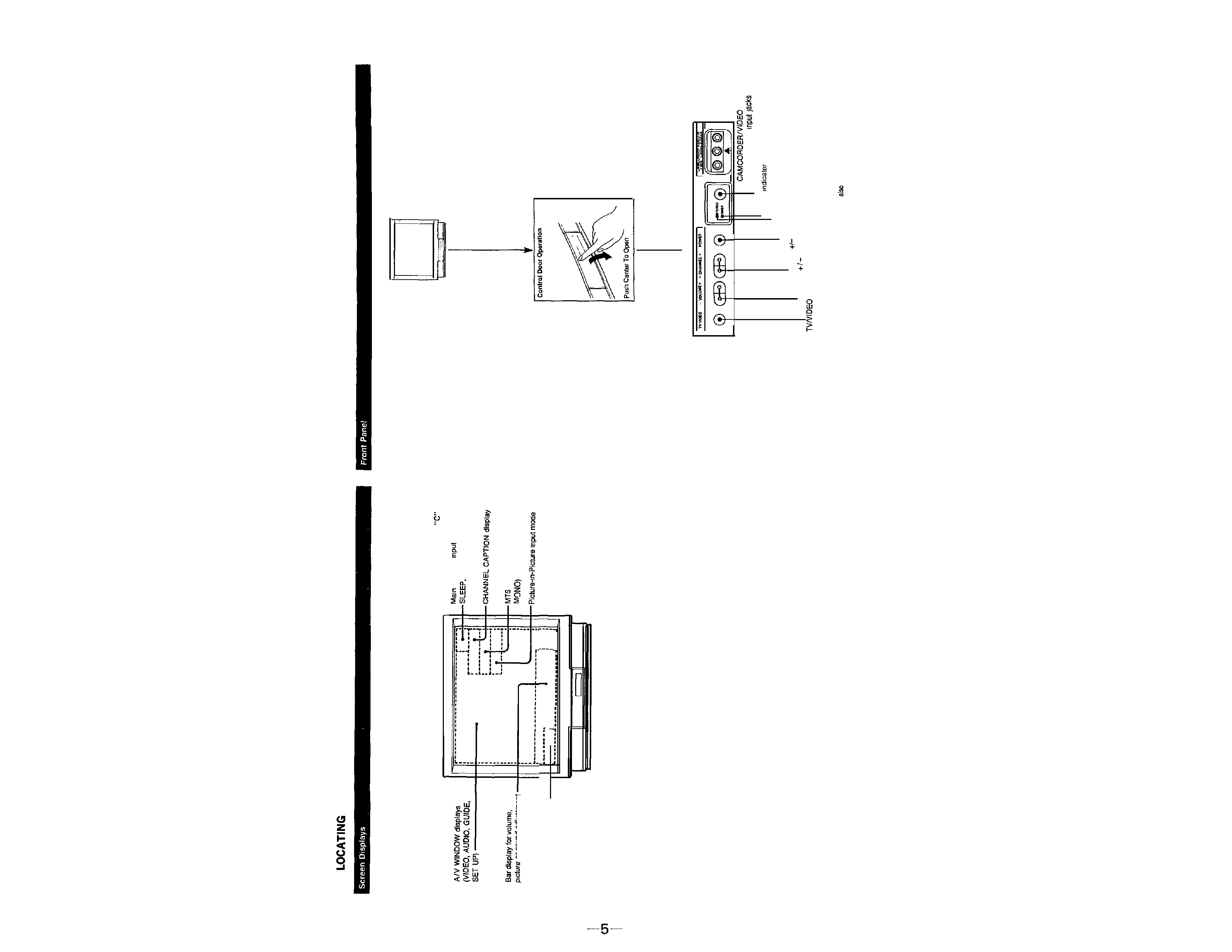
SECTION 1
GENERAL
l-l.
THE CONTROLS
Channel number/cable
displays
Picture
mode
MUTING displays
or sound adjustment
mode (MAIN, SAP or
CURRENT TIME display
.
SURROUND display
____
IN
VIDEO, AUDIO
Remote detector
TIMER
lamp
STEREO Indicator lamp
POWER button*
CHANNEL
buttons*
VOLUME
buttons*
button*
*Buttons with the same function are
located on the Remote
Commander.
